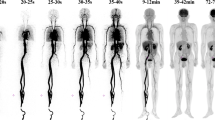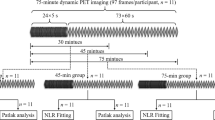Abstract
Purpose
This study aims to evaluate dynamic 2-deoxy-2-[18F]fluoro-d-glucose (FDG) uptake in normal tissues.
Procedures
Thirty male patients underwent FDG positron emission tomography (PET)/computed tomography imaging at 1, 2, and 3 h after tracer injection. Standardized uptake values (SUV) were obtained in regions of interest of normal tissues.
Results
The aorta (blood pool), liver, and spleen FDG activity demonstrated significantly and continuously decreased activity from 1 to 2 and 2 to 3 h, while FDG uptake in the lungs, pancreas, lymph nodes, and skeletal muscle decreased from 1 to 2 h only. In contrast, the left ventricular myocardium demonstrated two patterns of dynamic changes: myocardium with higher FDG uptake (SUVmax ≥ 3.25) on the initial images had more remarkable increased activity on the delayed images, while myocardium with lower FDG uptake (SUVmax < 3.25) on the initial imaging had no increased uptake on delayed imaging. Increased FDG uptake was also observed in the bones on the delayed images. No significant changes of FDG uptake were noted in the parotid gland, thyroid gland, and prostate gland.
Conclusions
These findings may help nuclear medicine physicians when comparing images performed at different time points, when using FDG uptake in internal reference regions as a relative indicator of FDG uptake in a specific lesion, and when reading a delayed FDG PET imaging.




Similar content being viewed by others
References
Hustinx R, Smith RJ, Benard F et al (1999) Dual time point fluorine-18 fluorodeoxyglucose positron emission tomography: a potential method to differentiate malignancy from inflammation and normal tissue in the head and neck. Eur J Nucl Med 26:1345–1348
Zhuang H, Pourdehnad M, Lambright ES et al (2001) Dual time point 18F-FDG PET imaging for differentiating malignant from inflammatory processes. J Nucl Med 42:1412–1417
Matthies A, Hickeson M, Cuchiara A et al (2002) Dual time point 18F-FDG PET for the evaluation of pulmonary nodules. J Nucl Med 43:871–875
Alkhawaldeh K, Bural G, Kumar R et al (2008) Impact of dual-time-point (18)F-FDG PET imaging and partial volume correction in the assessment of solitary pulmonary nodules. Eur J Nucl Med Mol Imag 35:246–252
Chen YK, Shen YY, Kao CH (2004) Dual-phase F-18 FDG PET cannot increase the diagnostic accuracy to differentiate solitary pulmonary nodules. Clin Nucl Med 29:281–283
Laffon E, de Clermont H, Begueret H et al (2009) Assessment of dual-time-point 18F-FDG-PET imaging for pulmonary lesions. Nucl Med Comm 30:455–461
Schillaci O, Travascio L, Bolacchi F et al (2009) Accuracy of early and delayed FDG PET-CT and of contrast-enhanced CT in the evaluation of lung nodules: a preliminary study on 30 patients. Radiol Med 114:890–906
Cloran FJ, Banks KP, Song WS et al (2010) Limitations of dual time point PET in the assessment of lung nodules with low FDG avidity. Lung Cancer 68:66–71
Higashi T, Saga T, Nakamoto Y et al (2002) Relationship between retention index in dual-phase (18)F-FDG PET, and hexokinase-II and glucose transporter-1 expression in pancreatic cancer. J Nucl Med 43:173–180
Delbeke D, Coleman RE, Guiberteau MJ et al (2006) Procedure guideline for tumor imaging with 18F-FDG PET/CT 1.0. J Nucl Med 47:885–895
Boellaard R, O’Doherty MJ, Weber WA et al (2010) FDG PET and PET/CT: EANM procedure guidelines for tumour PET imaging: version 1.0. Eur J Nucl Med Mol Imag 37:181–200
Lowe VJ, DeLong DM, Hoffman JM et al (1995) Optimum scanning protocol for FDG-PET evaluation of pulmonary malignancy. J Nucl Med 36:883–887
Gupta N, Gill H, Graeber G et al (1998) Dynamic positron emission tomography with F-18 fluorodeoxyglucose imaging in differentiation of benign from malignant lung/mediastinal lesions. Chest 114:1105–1111
Kubota K, Itoh M, Ozaki K et al (2001) Advantage of delayed whole-body FDG-PET imaging for tumour detection. Eur J Nucl Med 28:696–703
Chin BB, Green ED, Turkington TG et al (2009) Increasing uptake time in FDG-PET: standardized uptake values in normal tissues at 1 versus 3 h. Mol Imag Biol 11:118–122
Nishiyama Y, Yamamoto Y, Fukunaga K et al (2006) Dual-time-point 18F-FDG PET for the evaluation of gallbladder carcinoma. J Nucl Med 47:633–638
Arena V, Skanjeti A, Casoni R et al (2008) Dual-phase FDG-PET: delayed acquisition improves hepatic detectability of pathological uptake. Radiol Med 113:875–886
Dirisamer A, Halpern BS, Schima W et al (2008) Dual-time-point FDG-PET/CT for the detection of hepatic metastases. Mol Imag Biol 10:335–340
Juweid ME, Stroobants S, Hoekstra OS et al (2007) Use of positron emission tomography for response assessment of lymphoma: consensus of the Imaging Subcommittee of International Harmonization Project in Lymphoma. J Clin Oncol 25:571–578
Caraco C, Aloj L, Chen LY et al (2000) Cellular release of [18F]2-fluoro-2-deoxyglucose as a function of the glucose-6-phosphatase enzyme system. J Biol Chem 275:18489–18494
Keiding S (2012) Bringing physiology into PET of the liver. J Nucl Med 53:425–433
Lin W-Y, Tsai S-C, Hung G-U (2005) Value of delayed 18F-FDG-PET imaging in the detection of hepatocellular carcinoma. Nucl Med Comm 26:315–321
Wolfort RM, Papillion PW, Turnage RH et al (2010) Role of FDG-PET in the evaluation and staging of hepatocellular carcinoma with comparison of tumor size, AFP level, and histologic grade. Intern Surg 95:67–75
Lee JW, Kim SK, Lee SM et al (2011) Detection of hepatic metastases using dual-time-point FDG PET/CT scans in patients with colorectal cancer. Mol Imaging Biol 13:565–572
Fuster D, Lafuente S, Setoain X et al (2012) Dual-time point images of the liver with (18)F-FDG PET/CT in suspected recurrence from colorectal cancer. Rev Esp Med Nucl 31:111–116
Kumar R, Loving VA, Chauhan A et al (2005) Potential of dual-time-point imaging to improve breast cancer diagnosis with (18)F-FDG PET. J Nucl Med 46:1819–1824
Mavi A, Urhan M, Yu JQ et al (2006) Dual time point 18F-FDG PET imaging detects breast cancer with high sensitivity and correlates well with histologic subtypes. J Nucl Med 47:1440–1446
Kubota K, Watanabe H, Murata Y et al (2011) Effects of blood glucose level on FDG uptake by liver: a FDG-PET/CT study. Nucl Med Biol 38:347–351
Acknowledgments
This study was supported in part by a grant from the Department of Veterans Affairs (VISN 4 CPPF grant).
Conflict of Interest
None.
Author information
Authors and Affiliations
Corresponding authors
Rights and permissions
About this article
Cite this article
Cheng, G., Alavi, A., Lim, E. et al. Dynamic Changes of FDG Uptake and Clearance in Normal Tissues. Mol Imaging Biol 15, 345–352 (2013). https://doi.org/10.1007/s11307-012-0600-0
Published:
Issue Date:
DOI: https://doi.org/10.1007/s11307-012-0600-0




